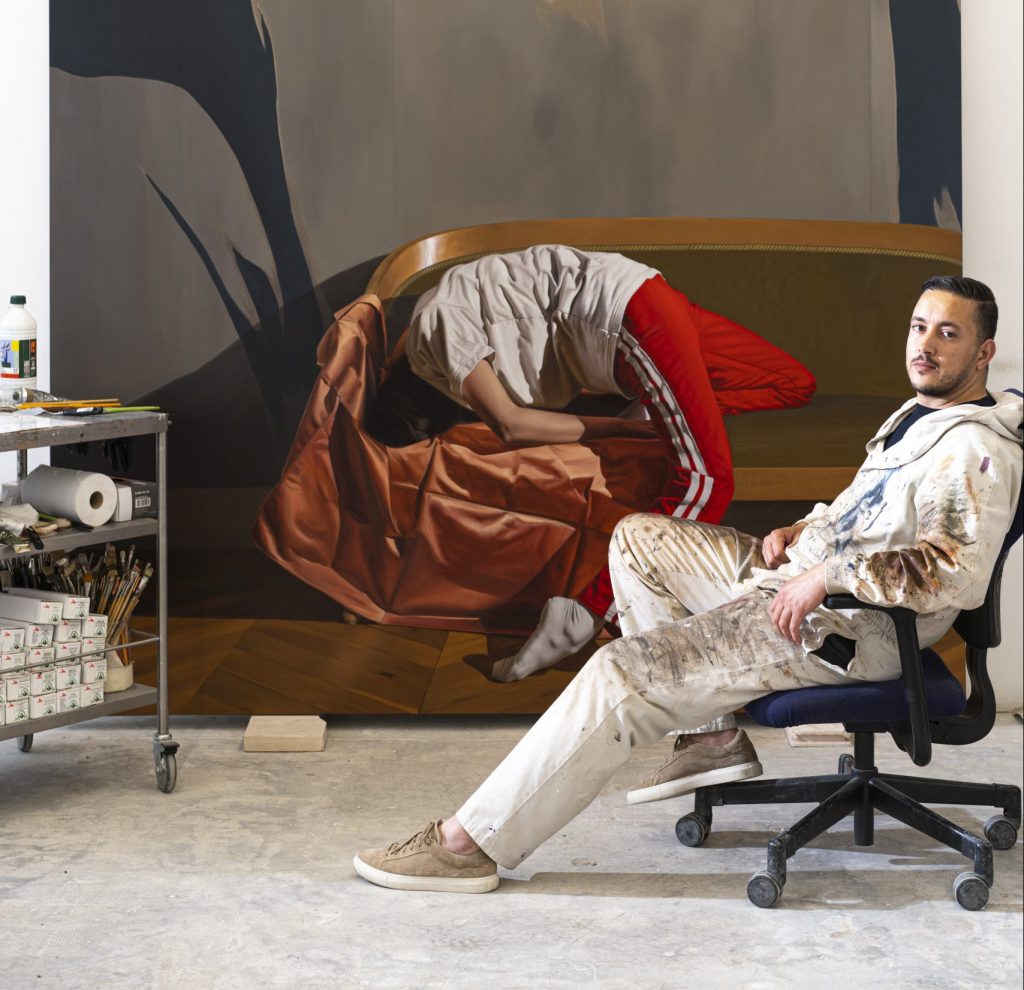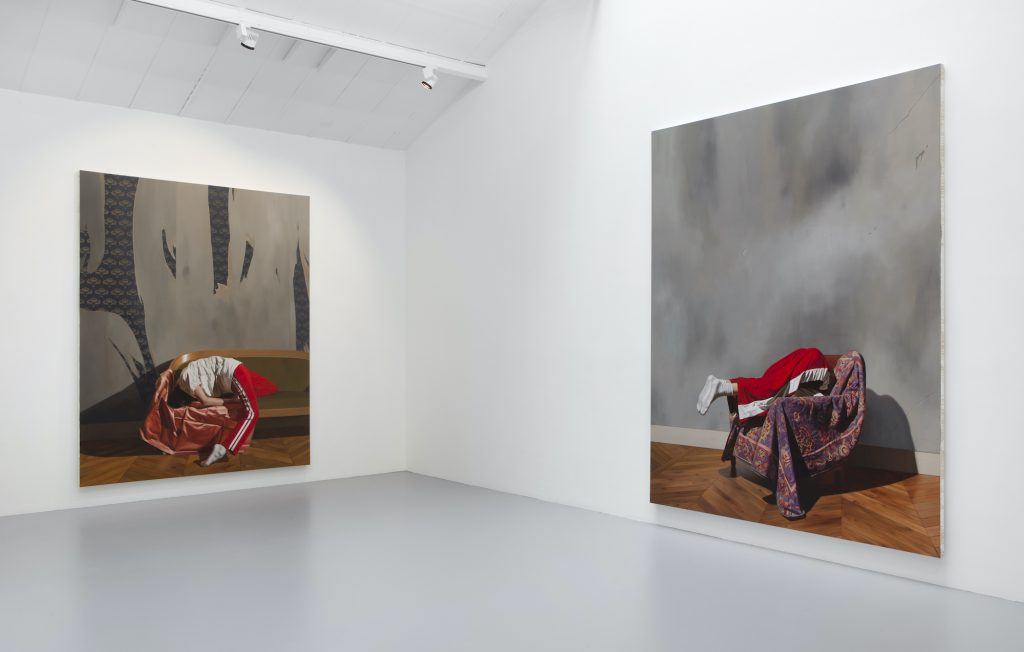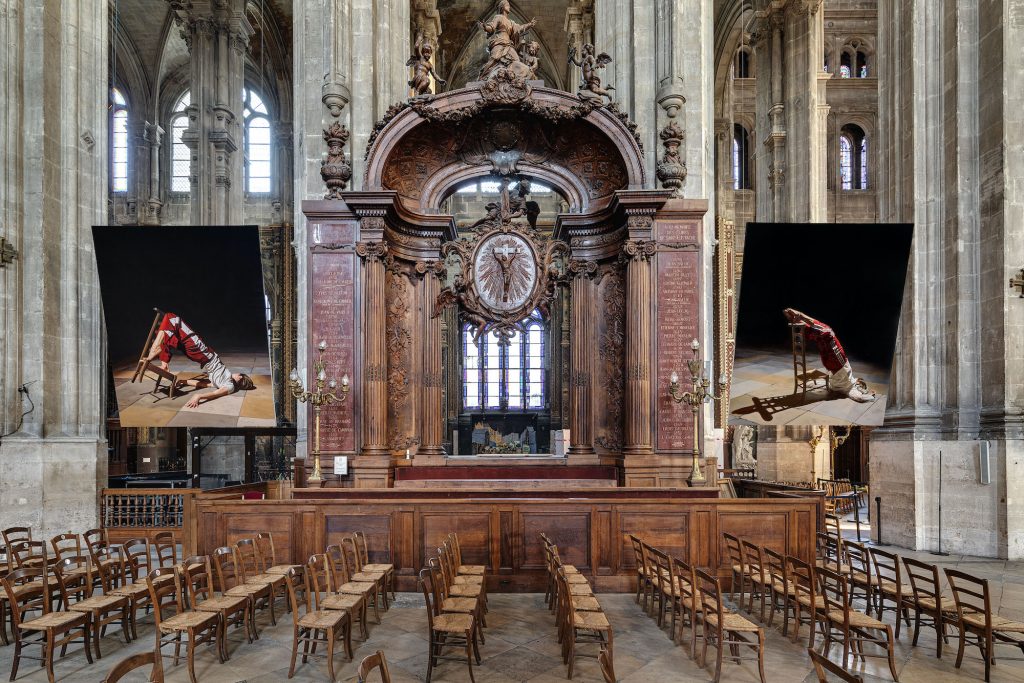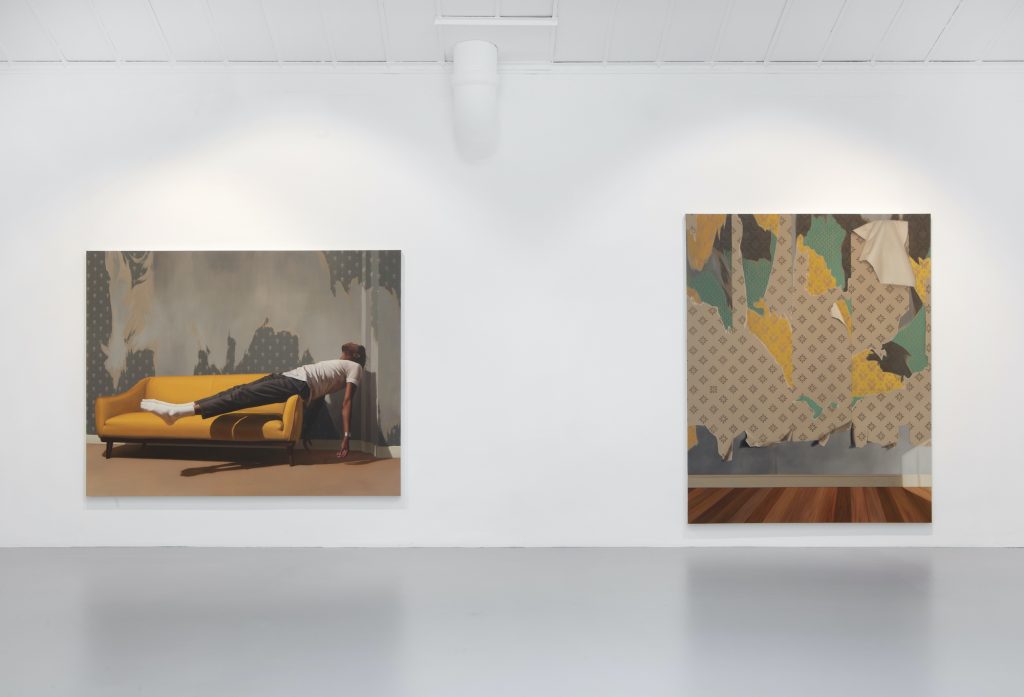Art World
A Top Dealer Noticed Dhewadi Hadjab’s Arresting Portraits in a Paris Church. Now the Algerian-Born Artist Is Getting His Big Break
The artist's first solo show with art dealer Kamel Mennour earlier this fall sold out immediately.

The artist's first solo show with art dealer Kamel Mennour earlier this fall sold out immediately.

Devorah Lauter

The Paris-based, Algerian-born Dhewadi Hadjab, paints dancers. We find them at the center of otherwise stark rooms, where layers of wallpaper are peeling off walls. They are often wearing Adidas sweatpants, their bodies twisted and suspended.
At the center of several compositions, feet pop up or hang, appearing relaxed, peaking over the back of a couch, and covered in the thick, cheap socks sold in bulk at sports shops or grocery stores. Faces are tucked away, and bodies become part of the pieces of furniture they are wrapped around. Despite sometimes holding painful, almost violent poses, these figures can also seem slumped and half asleep—puppets that have just been dropped from an invisible creator’s hand.
Our daily struggles, “what we’re living in our society today,” and certainly our failures, are among Hadjab’s obsessions, which he realistically depicts from photographs he alters on large canvases. His mother’s handwoven carpets are also at the heart of his process, which he likens to choreography.
“Growing up, I remember [my mother] worked by the kitchen, and there were all these colors and threads spilling over everywhere. When she wove, she tapped the threads repeatedly with her metal pick, and strung them through until things started to take shape,” Hadjab said, speaking from his studio at the shared artist space, Poush Manifesto, in a northern Paris suburb.

Insallation view of the solo show “Dhewadi Hadjab, Act I: Vaciller,” at Kamel Mennour in Paris. © Dhewadi Hadjab. Photo: Courtesy the artist and kamel mennour, Paris.
“It takes time and it’s a rhythmic, hypnotic gesture. Dancing is also a kind of weaving, a linking together of gestures and characters, and a carpet is a kind of choreography,” the artist added. “I realized much later, but my example of another artist was always there: it was my mother.”
Hadjab’s mother also told him the only way women in their culture could traditionally communicate with their married daughters was by sending each other carpets with encrypted messages in the motifs. “Inside there were woven codes and symbols that said how they felt,” he explained.
With paintings that touch on contemporary street culture, his Algerian origins and his more recent immigrant experience, Hadjab has struck a nerve in France’s art scene, joining a younger generation of emerging artists that reflect the country’s multiple identities. His first solo exhibition, “Act I: Vaciller,” at Kamel Mennour gallery, held earlier this fall, was a smash-hit—and don’t even ask about trying to acquire a piece. The gallery’s eponymous founder says he can no longer answer all the “frustrated” requests “from all over the world.”
Mennour began representing Hadjab after he saw the artist’s monumental paintings in Paris’ Sainte-Eustache church last year. In them, dancers wrangle with pews identical to the ones in the church. “It blew my eyes,” Mennour told Artnet News in one of his four Paris galleries. Just prior to that, and after a difficult bout with Covid that made him feel “too old,” Mennour, 56, had resigned himself to “letting the younger generation of galleries” represent emerging artists.
“But I made a mistake,” he admitted. It took him a year, he said, to feel he could fully commit to Hadjab, but after seeing the Sainte-Eustache exhibit in particular, he felt “in complete correspondence with the physicality” of Hadjab’s works. “It was so beautiful, and evoked architecture, our time, religion,” the dealer said. “There’s also this deliverance… a kind of violence and grace.” Mennour called Hadjab while he was in the middle of the exhibition in the church, and even though he is normally “totally not into figurative art,” this was different.
“Let’s get married,” the dealer proposed.

Installation view Dhewadi Hadjab’s 2021 exhibition in the church of Saint-Eustache in Paris. Photo: Romain Darnaud.
Hadjab was born in a small, conservative village in Algeria named M’Sila, where he had little exposure to other artists, and had to convince his parents he was not committing blasphemy by painting human figures—a forbidden practice according to some interpretations of Islam. Though his parents have been very supportive of his career choice, some earlier convincing was needed. “The deal was, if our religion accepts it, fine. If not, we reject it,” he remembers, calling that period “a bit destabilizing.”
But around the age of 14 and 15, he researched the question of human representation in his culture, “made my arguments, and in the end, they were pretty open-minded,” Hadjab said. “It got easier after that, so I was able to continue drawing and making paintings.” (His case, for those interested in the philosophical argument, consisted of proving to his parents that drawing and painting another human being did not equate to creating another being with a soul.)
Other than his middle school teacher, who introduced him to drawing and encouraged him, Hadjab didn’t know any other professional artists, or anything about art school. His mother’s imaginative weaving was for pleasure. “I had to reassure my parents, and I told them I could teach—but that was never my goal.”
In the end, he paid his way through three art schools, mostly by making copies of Orientalist paintings. He began at the Ecole Supérieure des Beaux Arts d’Alger, and then came to France, for the Ecole Nationale Superieure d’Art de Bourges, before finally realizing his dream of studying at the Beaux Arts de Paris.
But little, if any part of it, was easy. Once in France, “everything was new, the food, the climate, the way people speak, and carry themselves,” he said. He also had to learn French, which he did in just a few years. Hadjab says his work talks about the kinds of struggles he experienced—and continues to experience—as an immigrant, though he doesn’t categorize it as political.

Insallation view of the solo show “Dhewadi Hadjab, Act I: Vaciller,” at Kamel Mennour in Paris. © Dhewadi Hadjab. Photo: Courtesy the artist and kamel mennour, Paris.
He adds that he is greatly inspired by choreographer Pina Bausch, in the way she pushes the body’s physical limits, and is devoted to Caravaggio, while looking at Borremans, David Hockney, and Richter, to name a few.
Hadjab says he often hides the faces of his figures, or keeps their eyes closed, to allow the viewer to easily enter the painting, while also rendering the subjects more sculpture-like, and less human.
“There is no dialogue between the model and the viewer, and it’s intentional,” Hadjab said. “I try to make the body like an object of décor – it becomes sculptural, through the rigidity of the posture, or the difficult position,” he said “And inversely, I try to make the couch or the chair almost come alive, through this dialogue.”
By objectifying his subjects, the viewer is paradoxically reminded of their human fragility, avulnerability Hadjab said he is particularly drawn to. After he watched a friend’s contemporary dance rehearsal, he remembered that “the moments that interested me most, were when the dancers start to work on a move, and it got botched. When it was imperfect, more than the final, clean dance move,” Hadjab said. To that end, his paintings explore the notion of failure, which the artist said “is what pushes us forward and feeds us.”
The ripped wallpaper patterns are another reference to failure, the artist added, and the literal, repetitive layering that can happen when painting. Hadjab says he uses various techniques, including those of the Renaissance, starting with a gray under-painting, and later going over it with color and highlights. Working on four or five paintings at once, it takes him about a month to complete a single work.
With his work priced between €8,000 and €40,000, Mennour said the gallery’s first show sold out “immediately.” One painting, donated by the artist and gallery to Mennour’s charity for a children’s hospital in Paris, sold for €200,000 at auction, the dealer told Artnet News. Still, Mennour said he’s keeping prices in check within Hadjab’s primary market.

Insallation view of the solo show “Dhewadi Hadjab, Act I: Vaciller,” at Kamel Mennour in Paris. © Dhewadi Hadjab. Photo: Courtesy the artist and kamel mennour, Paris.
“We’re not putting him in this race, which is all about unreasonable speculation,” the dealer said. “I told him that you either want to be in this race, and you’ll rise extremely fast, but also disappear extremely fast, or you want to work within art history. And maybe we’ll fail, or maybe we’ll stay and say something, but we need time.”
The gallerist said three institutions had acquired Hadjab’s work from the last show, and that he was working towards other projects with institutions and biennales.
Though unable to get into too much detail, Hadjab felt he has a lot to look forward to, hinting: “We have some beautiful projects coming up.”
More Trending Stories: